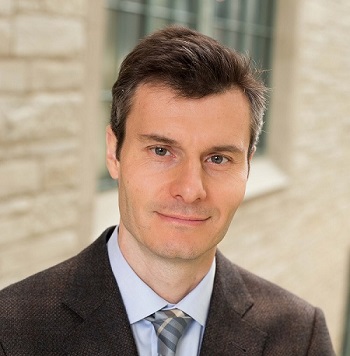User login
Nanotechnology is positioned to bring fundamental changes to the diagnosis and treatment of GI diseases, according to the Vadim Backman, MS, PhD, professor of biomedical engineering at the McCormick School of Engineering, Northwestern University, Chicago.
“The ways in which nanotechnology will change the field are going to be quite significant,” Dr. Backman said. He will give the Keynote Presentation at the 2018 AGA Tech Summit, sponsored by the AGA Center for GI Innovation and Technology. He described progress toward breakthroughs in diagnostics – particularly early detection of GI cancers – and therapeutics, such as nanocage transport of drugs across cell membranes. Applications have moved beyond the theoretical.
Nanotechnology is a broad term that involves manipulation of any material on a nano scale, often defined, although not strictly, as less than 100 nanometers (nm). Most bacteria measure more than 1000 nm in at least one direction. A DNA nucleotide is 2 nm. In the diagnosis and treatment of human diseases, the advantages of working on a nanoscale mean opportunities to act on the most fundamental molecular processes, including the earliest stages of pathophysiology.
In diagnosis, nanotechnology has the ability to detect genetic and epigenetic distortions that are initial steps to carcinogenesis. One set of studies has been performed with partial-wave spectroscopic microscopy capable of quantifying the properties of cellular structures on a scale as low as 20 nm. Work in this area has already successfully identified events in neoplasia development that preceded any alteration detected by conventional techniques, such as histology.
“With nanoscale sensitive optics, it is now possible to detect changes in cell and tissue structure that we have connected to the earliest steps in tumorigenesis,” Dr. Backman said. This work largely derives from progress in defining the topography of chromatin, a term that encompasses the protein, DNA, RNA, and protein composition of chromosomes. The work is relevant to all solid tumors, not just GI cancers. Based on the current status of the science, Dr. Backman foresees not just detection of the earliest events in cancer development but opportunities to tailor epigenetic therapies for personalized medicine.
In regard to other opportunities to improve diagnostics in GI diseases through nanotechnology, Dr. Backman spoke of nanoscale constructs that serve as contrast agents to visualize molecular structures and processes. These can be delivered endoscopically or systemically to provide unprecedented 3-D imaging, allowing such structures as cell receptors to be visualized and labeled.
The potential therapeutic applications of nanotechnology involve new approaches to altering disease progression. In addition to explaining the novel opportunities provided by delivering drugs on a nanoscale to alter cell processes in a way that would not be otherwise possible, Dr. Backman described how nanotechnology can be applied to influence global patterns in gene transcription. This is achieved by altering the chromatin structure.
“It is now understood that chromatin acts like software in mediating gene activities,” Dr. Backman explained. “In the case of cancer, normalization of chromatin structure can predictably modulate global patterns of gene expression. There is now evidence that modulation of chromatin structure with macrogenomic engineering may address cancer as well as other illnesses.”
In most cases, the advances described by Dr. Backman are not speculations based on the potential of the technology but concepts that are actively being developed. Partial-wave spectroscopic microscopy, which was developed in Dr. Backman’s laboratory, is permitting the nuclear nanostructure in live cells to be evaluated in real time, while progress in epigenetics is explaining which processes might be candidates for preventing or treating disease.
“Nanotechnology is positioned to advance personalized medicine and tailored therapeutics,” Dr. Backman said. “We do not yet have applications ready for regulatory approval, but they are coming.”
Nanotechnology is positioned to bring fundamental changes to the diagnosis and treatment of GI diseases, according to the Vadim Backman, MS, PhD, professor of biomedical engineering at the McCormick School of Engineering, Northwestern University, Chicago.
“The ways in which nanotechnology will change the field are going to be quite significant,” Dr. Backman said. He will give the Keynote Presentation at the 2018 AGA Tech Summit, sponsored by the AGA Center for GI Innovation and Technology. He described progress toward breakthroughs in diagnostics – particularly early detection of GI cancers – and therapeutics, such as nanocage transport of drugs across cell membranes. Applications have moved beyond the theoretical.
Nanotechnology is a broad term that involves manipulation of any material on a nano scale, often defined, although not strictly, as less than 100 nanometers (nm). Most bacteria measure more than 1000 nm in at least one direction. A DNA nucleotide is 2 nm. In the diagnosis and treatment of human diseases, the advantages of working on a nanoscale mean opportunities to act on the most fundamental molecular processes, including the earliest stages of pathophysiology.
In diagnosis, nanotechnology has the ability to detect genetic and epigenetic distortions that are initial steps to carcinogenesis. One set of studies has been performed with partial-wave spectroscopic microscopy capable of quantifying the properties of cellular structures on a scale as low as 20 nm. Work in this area has already successfully identified events in neoplasia development that preceded any alteration detected by conventional techniques, such as histology.
“With nanoscale sensitive optics, it is now possible to detect changes in cell and tissue structure that we have connected to the earliest steps in tumorigenesis,” Dr. Backman said. This work largely derives from progress in defining the topography of chromatin, a term that encompasses the protein, DNA, RNA, and protein composition of chromosomes. The work is relevant to all solid tumors, not just GI cancers. Based on the current status of the science, Dr. Backman foresees not just detection of the earliest events in cancer development but opportunities to tailor epigenetic therapies for personalized medicine.
In regard to other opportunities to improve diagnostics in GI diseases through nanotechnology, Dr. Backman spoke of nanoscale constructs that serve as contrast agents to visualize molecular structures and processes. These can be delivered endoscopically or systemically to provide unprecedented 3-D imaging, allowing such structures as cell receptors to be visualized and labeled.
The potential therapeutic applications of nanotechnology involve new approaches to altering disease progression. In addition to explaining the novel opportunities provided by delivering drugs on a nanoscale to alter cell processes in a way that would not be otherwise possible, Dr. Backman described how nanotechnology can be applied to influence global patterns in gene transcription. This is achieved by altering the chromatin structure.
“It is now understood that chromatin acts like software in mediating gene activities,” Dr. Backman explained. “In the case of cancer, normalization of chromatin structure can predictably modulate global patterns of gene expression. There is now evidence that modulation of chromatin structure with macrogenomic engineering may address cancer as well as other illnesses.”
In most cases, the advances described by Dr. Backman are not speculations based on the potential of the technology but concepts that are actively being developed. Partial-wave spectroscopic microscopy, which was developed in Dr. Backman’s laboratory, is permitting the nuclear nanostructure in live cells to be evaluated in real time, while progress in epigenetics is explaining which processes might be candidates for preventing or treating disease.
“Nanotechnology is positioned to advance personalized medicine and tailored therapeutics,” Dr. Backman said. “We do not yet have applications ready for regulatory approval, but they are coming.”
Nanotechnology is positioned to bring fundamental changes to the diagnosis and treatment of GI diseases, according to the Vadim Backman, MS, PhD, professor of biomedical engineering at the McCormick School of Engineering, Northwestern University, Chicago.
“The ways in which nanotechnology will change the field are going to be quite significant,” Dr. Backman said. He will give the Keynote Presentation at the 2018 AGA Tech Summit, sponsored by the AGA Center for GI Innovation and Technology. He described progress toward breakthroughs in diagnostics – particularly early detection of GI cancers – and therapeutics, such as nanocage transport of drugs across cell membranes. Applications have moved beyond the theoretical.
Nanotechnology is a broad term that involves manipulation of any material on a nano scale, often defined, although not strictly, as less than 100 nanometers (nm). Most bacteria measure more than 1000 nm in at least one direction. A DNA nucleotide is 2 nm. In the diagnosis and treatment of human diseases, the advantages of working on a nanoscale mean opportunities to act on the most fundamental molecular processes, including the earliest stages of pathophysiology.
In diagnosis, nanotechnology has the ability to detect genetic and epigenetic distortions that are initial steps to carcinogenesis. One set of studies has been performed with partial-wave spectroscopic microscopy capable of quantifying the properties of cellular structures on a scale as low as 20 nm. Work in this area has already successfully identified events in neoplasia development that preceded any alteration detected by conventional techniques, such as histology.
“With nanoscale sensitive optics, it is now possible to detect changes in cell and tissue structure that we have connected to the earliest steps in tumorigenesis,” Dr. Backman said. This work largely derives from progress in defining the topography of chromatin, a term that encompasses the protein, DNA, RNA, and protein composition of chromosomes. The work is relevant to all solid tumors, not just GI cancers. Based on the current status of the science, Dr. Backman foresees not just detection of the earliest events in cancer development but opportunities to tailor epigenetic therapies for personalized medicine.
In regard to other opportunities to improve diagnostics in GI diseases through nanotechnology, Dr. Backman spoke of nanoscale constructs that serve as contrast agents to visualize molecular structures and processes. These can be delivered endoscopically or systemically to provide unprecedented 3-D imaging, allowing such structures as cell receptors to be visualized and labeled.
The potential therapeutic applications of nanotechnology involve new approaches to altering disease progression. In addition to explaining the novel opportunities provided by delivering drugs on a nanoscale to alter cell processes in a way that would not be otherwise possible, Dr. Backman described how nanotechnology can be applied to influence global patterns in gene transcription. This is achieved by altering the chromatin structure.
“It is now understood that chromatin acts like software in mediating gene activities,” Dr. Backman explained. “In the case of cancer, normalization of chromatin structure can predictably modulate global patterns of gene expression. There is now evidence that modulation of chromatin structure with macrogenomic engineering may address cancer as well as other illnesses.”
In most cases, the advances described by Dr. Backman are not speculations based on the potential of the technology but concepts that are actively being developed. Partial-wave spectroscopic microscopy, which was developed in Dr. Backman’s laboratory, is permitting the nuclear nanostructure in live cells to be evaluated in real time, while progress in epigenetics is explaining which processes might be candidates for preventing or treating disease.
“Nanotechnology is positioned to advance personalized medicine and tailored therapeutics,” Dr. Backman said. “We do not yet have applications ready for regulatory approval, but they are coming.”

